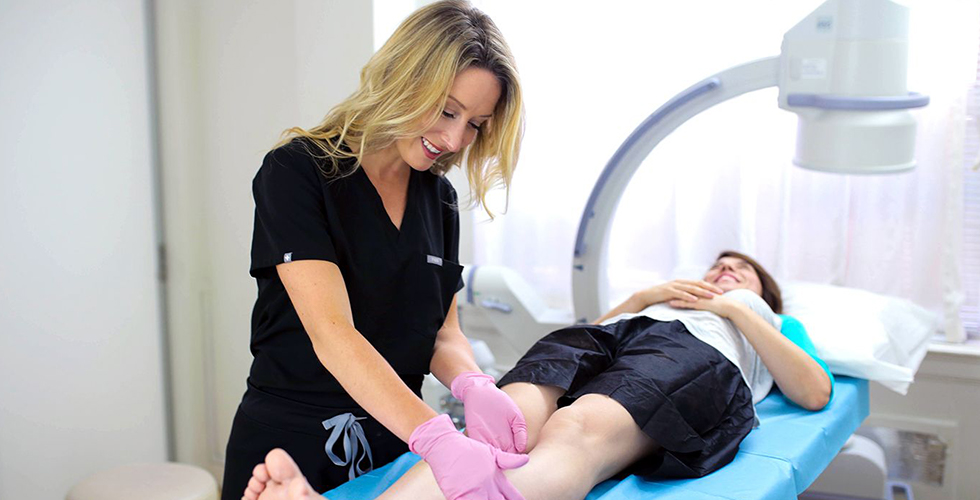What causes vein problems?
Vein problems are most commonly caused by chronic venous insufficiency (CVI). CVI occurs when the valves in your veins don’t work properly. These valves are responsible for keeping blood flowing in the right direction. When they don’t work properly, blood can flow backward and pool in your veins. This can cause your veins to become enlarged, twisted, and painful.
Numerous factors can contribute to CVI, including:
- If your parents or grandparents had vein problems, you’re more likely to have them as well.
- Age. The risk of venous insufficiency increases as you grow older.
- Gender. Women are more likely to develop venous insufficiency than men. This may be due to hormones, pregnancy, weight changes, and other factors.
- Obesity. Extra weight puts extra pressure on your veins and makes vein disease more likely.
- Sedentary lifestyle. Sitting or standing for long periods of time can contribute to CVI.
- Leg injury, deep vein thrombosis, and other conditions increase the risk of vein disease.
If you have any of these risk factors, you may be more likely to develop chronic venous insufficiency and other vein problems. However, vein disease can occur in anyone. Even if you don’t have any of the risk factors, you could still develop the condition. If you identify with any of the aforementioned risk factors, you should contact your vein doctor for preventative care.
While there are no definitive ways to prevent vein disease, certain lifestyle changes can reduce the risk. You should engage in activities that improve blood flow to your heart, such as regular cardiovascular exercise, running, swimming, cycling, and yoga. You should also elevate your legs while sitting down, wear compression stockings, and avoid sitting down for long periods.

What are the symptoms of vein disease?
Most people don’t know they have a problem with their veins until they see them bulging on the surface of their skin. But by then, the damage is already done. Unhealthy veins can cause a host of problems, including pain, swelling, skin ulcers, and blood clots. If you think you might have vein disease, it’s important to know the symptoms and to seek treatment as soon as possible.
One of the early signs of vein disease is spider veins. These are small, red, purple, or blue veins that twist and turn under the skin. They are usually found on the legs and face and can be a cosmetic nuisance. But they can also be a sign that the valves in your veins are not working properly. If left untreated, spider veins can progress to varicose veins.
Varicose veins are larger veins that are often raised above the surface of the skin. They can be blue, purple, or flesh-colored and are often swollen and painful. Varicose veins can occur anywhere on the body but are most common on the legs. Another symptom of vein disease is edema or swelling. This is caused by a build-up of fluid in the tissues and can be especially noticeable in the ankles and legs at the end of the day.
The following are some of the signs and symptoms of vein disease:
- Aching or throbbing in the legs
- Swelling in the legs or feet
- Heaviness or fatigue in the legs
- Cramping in the legs
- Itching or burning sensation in the legs
- Restless leg syndrome
- Open sores or ulcers on the legs
If you are experiencing any of these signs or symptoms of chronic venous insufficiency, you must consult a vein doctor. Long Island Vein Treatment is a group of medical centers for vein treatment led by board-certified vein experts specializing in minimally invasive varicose vein treatments in Long Island. We have offices in West Islip, Jericho, and Hampton Bays, where we offer the latest treatments for vein disease.
Please schedule an appointment at a medical center for varicose vein treatment in Long Island.
How can I identify varicose and spider veins?
Varicose veins are enlarged, bulging veins that are often blue or dark purple. They can occur anywhere on the body but are most commonly found on the legs. Varicose veins are caused by a backup of blood in the veins. This can happen when the valves that keep blood flowing in the veins become weak or damaged. Varicose veins usually bulge out of the skin’s surface.
Spider veins are small, thin veins that are often red, blue, or purple. They can occur anywhere on the body but are most commonly found on the face and legs. Spider veins can also be a sign of underlying venous insufficiency, but in some cases, they are harmless. Spider veins appear in dense clusters of blood vessels, and they don’t bulge outwards.
Varicose veins are larger than spider veins and are usually more painful. Varicose veins also bulge out of the skin’s surface and make your legs feel heavy or tired. Spider veins are smaller and usually don’t cause pain.
How to get rid of swollen varicose veins?
The only way to eliminate varicose veins permanently is with minimally invasive procedures at a vein doctor’s office. The vein doctor will carefully examine your leg veins, review your medical history, and curate a personalized vein treatment plan. Some of the best minimally invasive varicose vein treatments are endovenous laser ablation, radiofrequency ablation, venaseal, sclerotherapy, and ambulatory phlebectomy.
The most common minimally invasive treatment for varicose veins is sclerotherapy. In this procedure, a doctor injects a sclerosant solution into the vein, which causes it to collapse and fade away. Sclerotherapy is usually performed on small veins, and multiple injections may be necessary. Endovenous ablation and venaseal destroy the diseased saphenous vein responsible for your vein problems, thus rerouting the accumulated blood into healthier leg veins.
